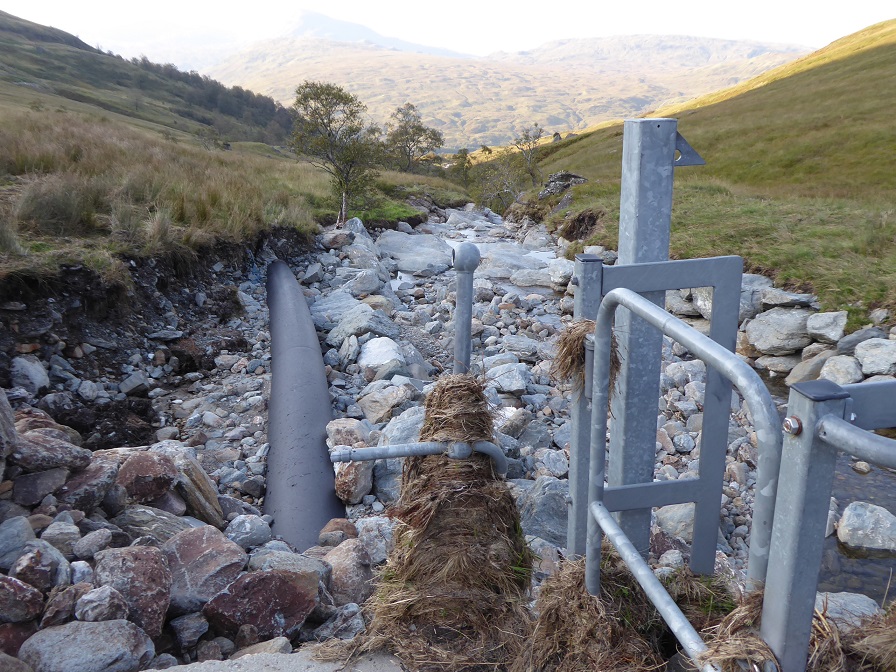
Ever since the storm which swept away part of the West Highland Line on 5th August I had been wondering what impact this had had on the hydro schemes there. I had been expecting it would have caused significant erosion of the hydro tracks, but never anticipated its impact on the hydro intakes. The extent of the destruction is considerable and has implications for run of river hydro schemes across Scotland. The issues are linked to the serious erosion that has taken place in the hills above which I covered in my last post (see here) but in turn has impacted on the natural environment below.
The infilling of the hydro intakes
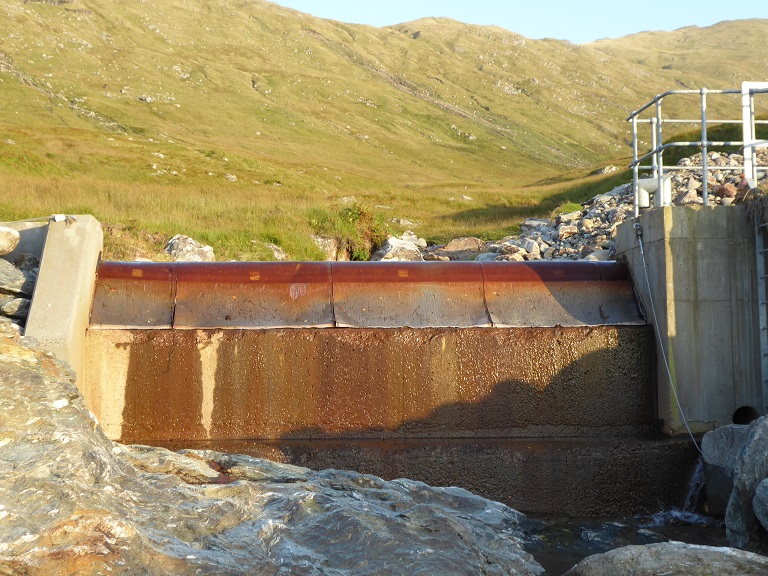
Debris from the landslip above and other more minor erosion events, along with rocks, gravel and sand in the river bed have all been swept down by the storm – nature at work – until they reached the artificial barrier created by the hydro dam wall which act like a rock wall. Its not surprising that the intake pools behind start to fill up with debris – parkswatch has covered this before – but the extent of the infilling caused by the storm event took me by surprise.
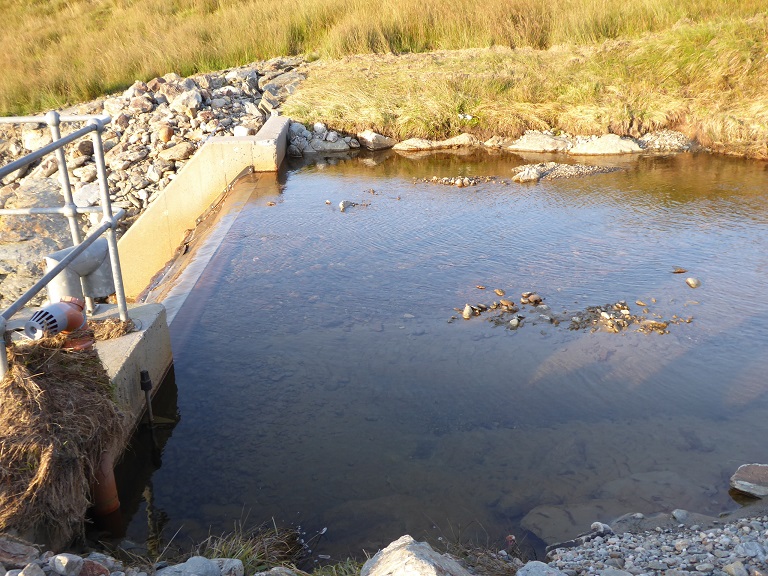
The intake pool has almost filled in and as a consequence boulders have been swept over the intake screen damaging it.
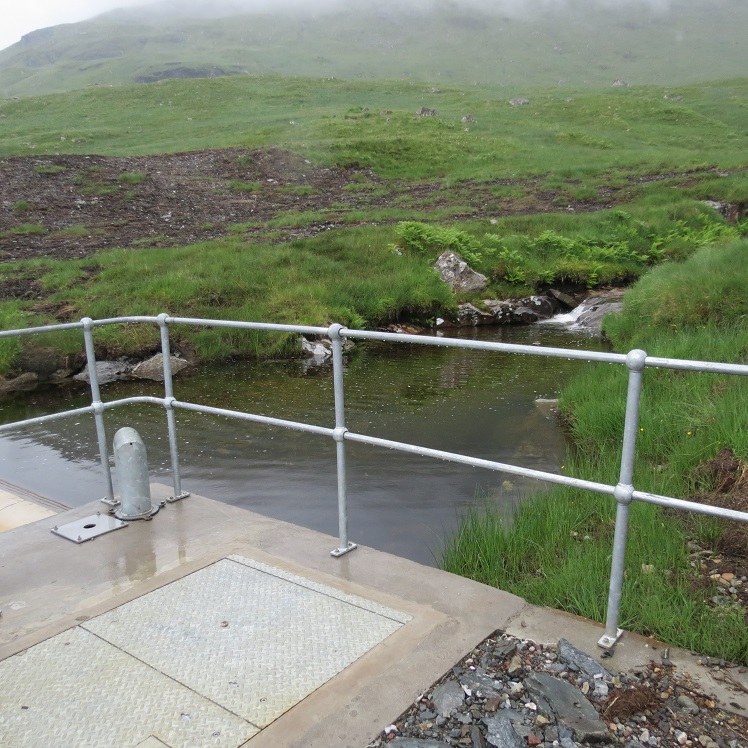
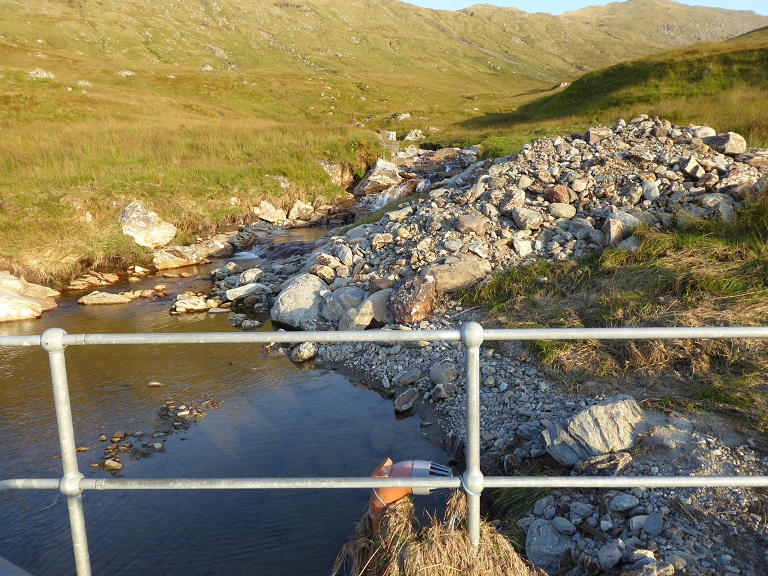
The deep grass sided pool I pictured 3 years ago has almost disappeared. I had been in a rush to catch my train when I got to the Allt Andoran and, until I compared my photos did not realise the pile of boulders behind the pool has almost certainly been excavated since the storm in order to prevent further damage to the intake and to keep it functioning.
There was conclusive evidence from two of the Allt a Chuillinn intakes that they have been excavated since the storm.

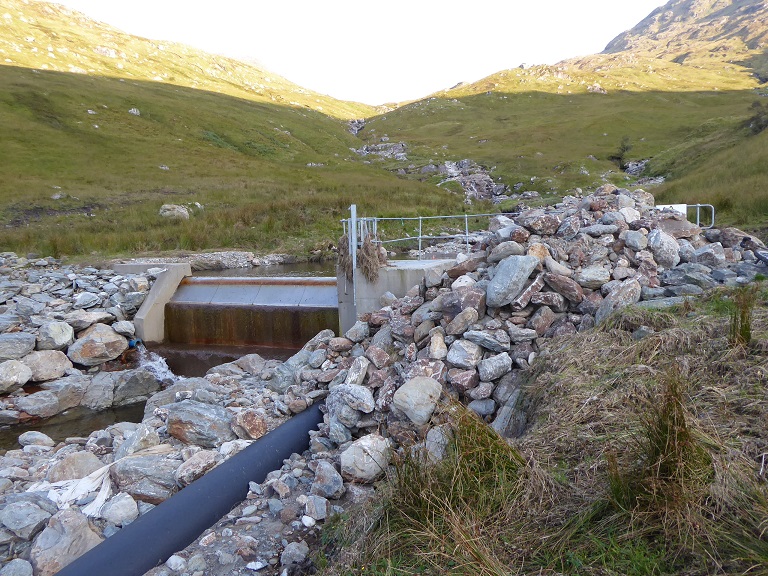
Construction and management of hydro intakes is regulated by the Scottish Environmental Protection Agency under the Controlled Activities Regulations. While routine maintenance of dams does not require permission, more extensive works do require permission. It would be interesting to know if SEPA have authorised the work in this case as it appears the pile of boulders has been placed on the dam prior to being used to cover up the exposed pipe below. I believe SEPA, who also regulate works to river banks, need to fully investigate what has happened here before deciding whether covering up the pipe again with boulders, when this has already failed once, is a sustainable proposition.
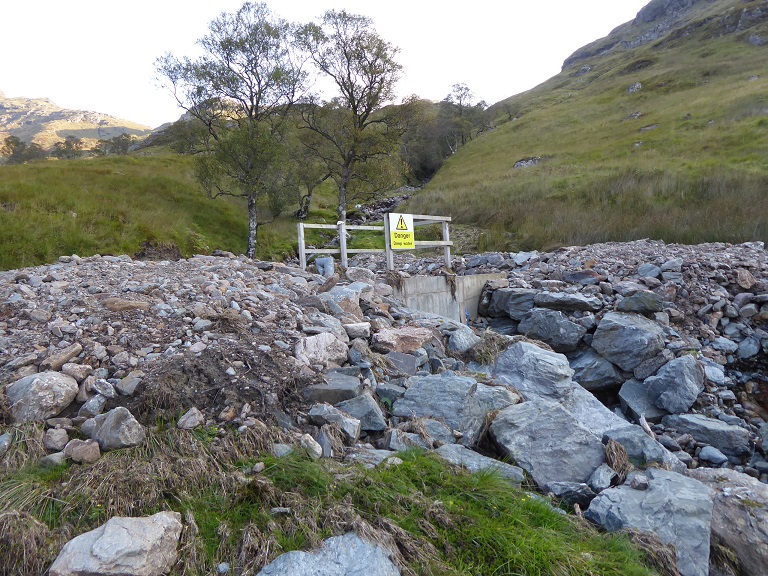
This second Allt A Chuillinn intake has also served to trap silt, mud, stones and boulders swept down the hill before being overwhelmed by it. The deep water danger sign is now……………..
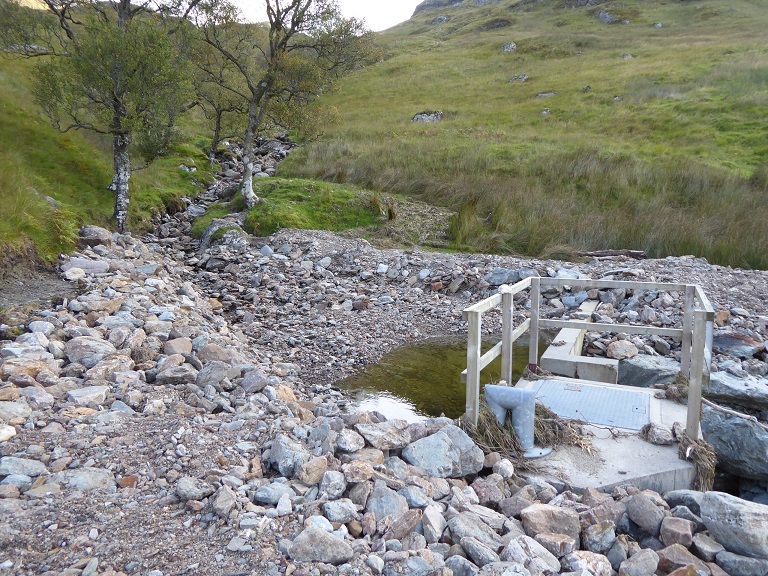
……………….redundant. What was the intake pool has however had to be excavated, probably to get the hydro working again but also to prevent the burn changing course and making the intake permanently redundant.
Whether the Loch Lomond and Trossachs National Park Authority has been notified of this work and consented to it is another question. There are no new planning applications for the Allt Chuillinn Scheme on the Park’s planning portal though the flood damage has clearly affected the “restoration” of all these schemes.
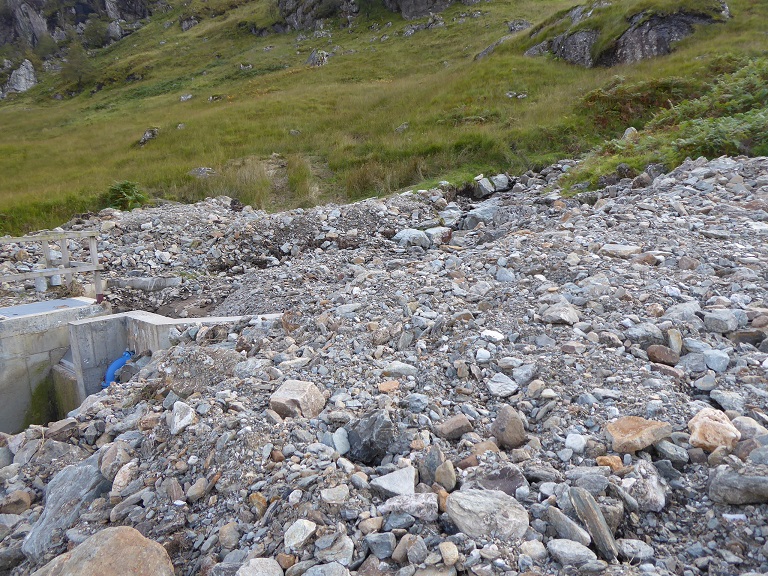
The third of the Allt a Chuillinn intakes has also been overwhelmed by flood debris, is high and dry and not functioning at all.
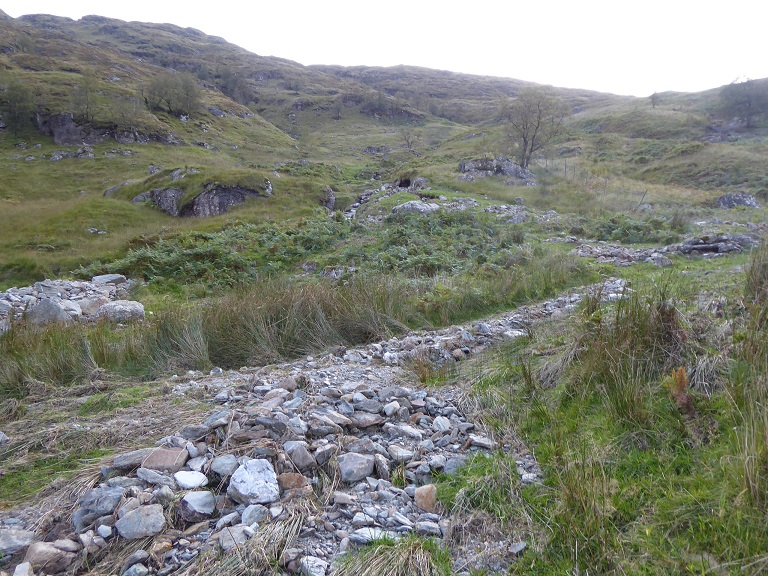
The burn appears almost to have changed course as a result of the flood event. Had that happened, further extensive engineering might have been required.
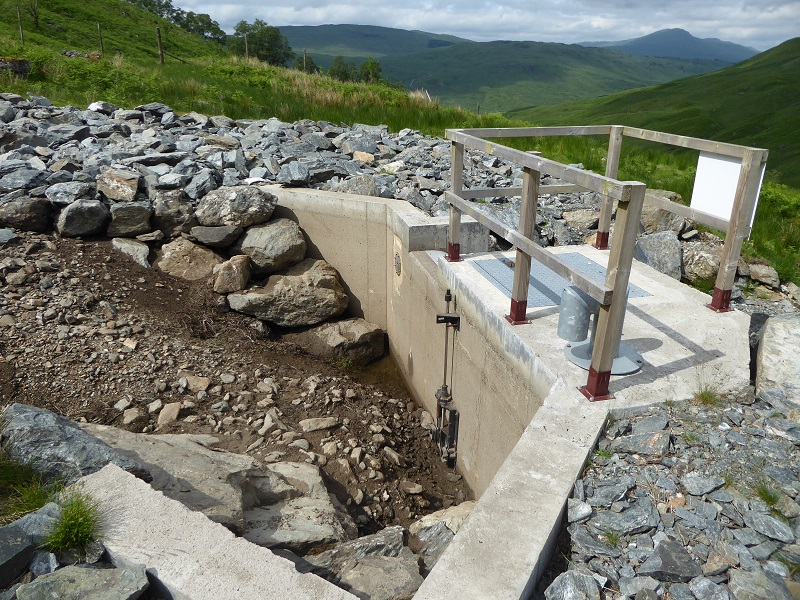
This intake, however, appears not to have been functioning for some time. 15 months ago when I visited, it appeared that due to poor design the water from the burn had found its way beneath it leaving what should have been a pool high and dry. Ironically, it could have started working for a time in the flood as the water which swept more rubble onto the ugly and highly artificial embankments was way above the level of the intake screen
What happens when intakes fail?
This raises the question of why the Glen Falloch Estate, which still appears to have a share in the ownership of this scheme, had not restored it and what, if anything, the Loch Lomond and Trossachs National Park Authority has done about this?
The implications are significant, not just for the Glen Falloch hydro schemes but for run of river hydro schemes across Scotland. First, where a scheme has failed due to design or construction flaws – as here – the first thing one would expect the owner to do is sue the designers and contractors. That can be difficult in a world where firms can go in and out of business as the result of a drop of a hat – let alone a thunderclap! Second, the owners could try to claim on their insurance. Evidence from the latest loan information for Osspower, the company which I understand operates this scheme, which is registered at Companies House, shows that the owners are required to have suitable insurance in place. So have the insurers accepted that this scheme was covered against failure? Third, in the year of its last accounts Osspower Ltd, made £180k net profit.
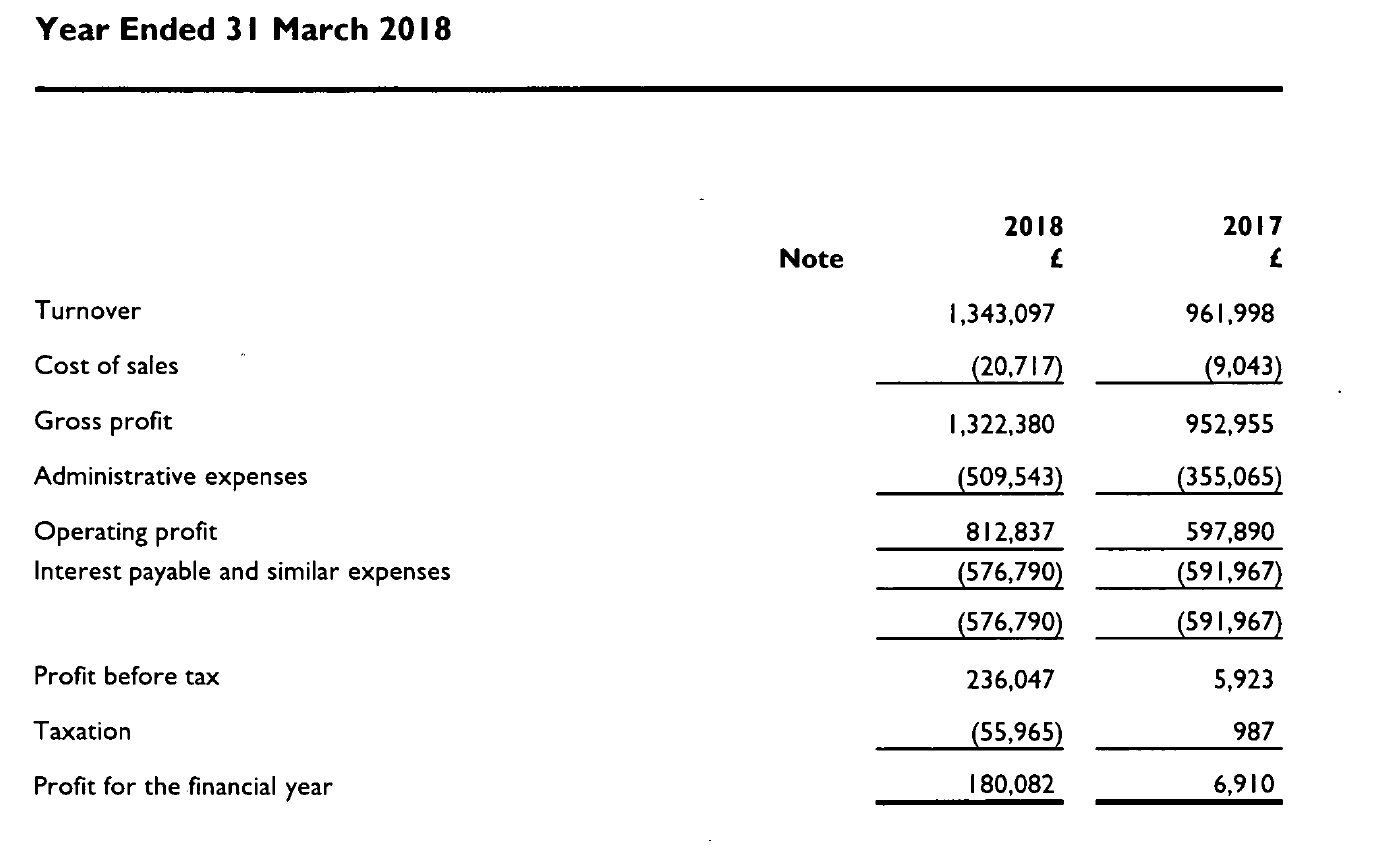
It thus had money to spare but has not fixed the scheme. Why?
Taken together all this raises doubts about whether this intake will ever be restored to working order. The issue now is not just that the intake was so badly designed that water flows under it. Its that the intake appears to be in the wrong place, if indeed there is a right place on a hillside like this, where its not uncommon for burns to change course.
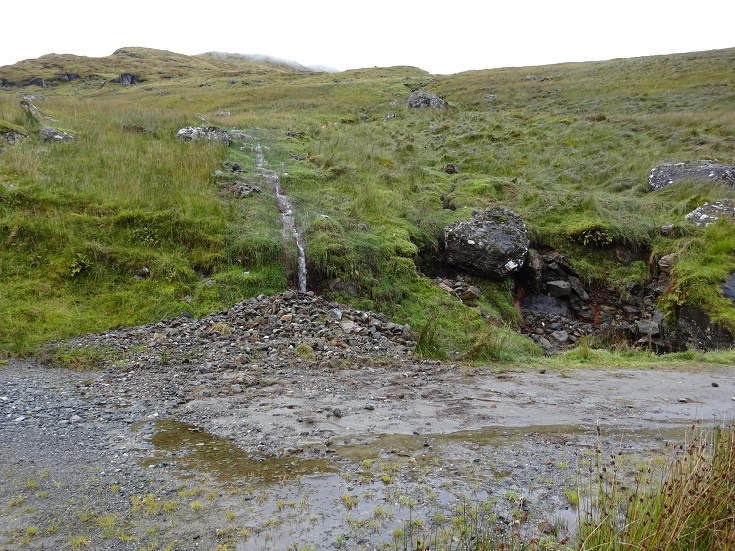
If the longstanding non-functioning Allt Chuillinn is not worth fixing, that raises serious concerns about whether all the other recent damage to the Glen Falloch Schemes will be properly restored and whether more of them will be abandoned in future. The evidence at present is that Glen Falloch estate is resorting to crude measures to get them working again – but for how long? What will happen after the next storm event?
The landscape, flood events and engineering
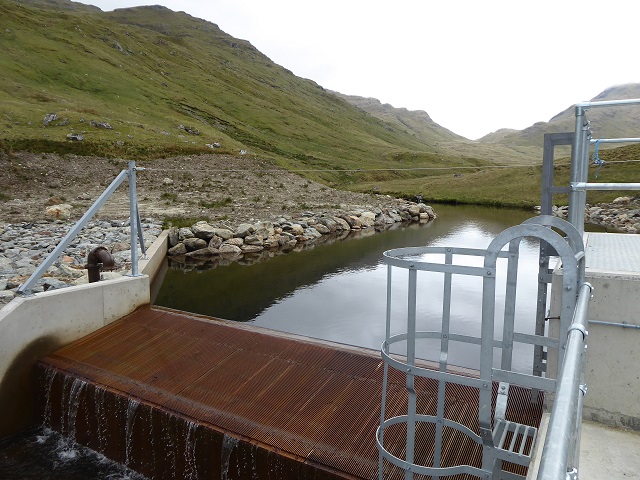
Back in May, when I last visited, behind the Upper Glen Falloch intake was a large deep artificially created pool (see here). I had up till now been critical of this pool from a landscape perspective, it formed a large ugly engineered area within what had been a wild glen and it appeared that the rip rap bouldering on the banks could take decades to revegetate. It was totally out of place in landscape terms.
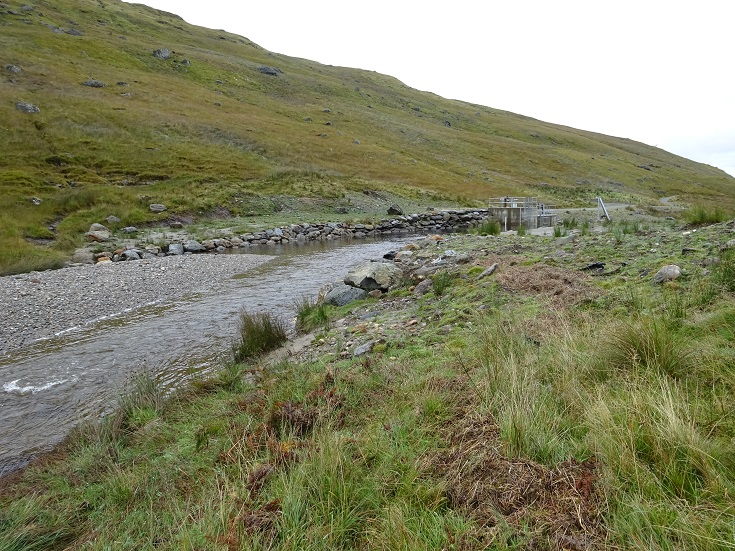
The deep pool however is no longer!
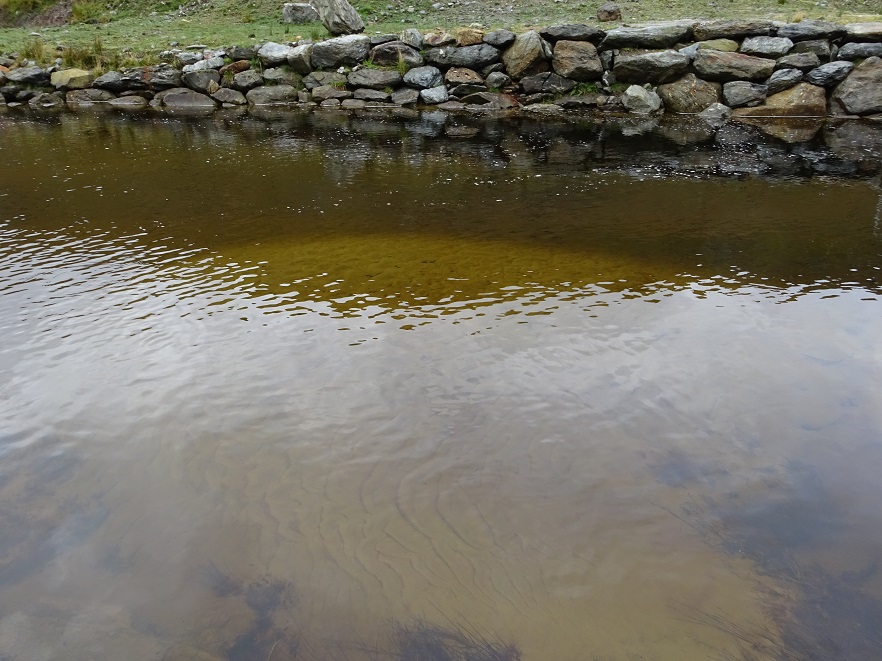
The extent to which this pool has been infilled is striking, its being reclaimed by nature……………..a good thing, which has softened to an extent its artificial contours, but quite incompatible with the ability of this scheme to generate electricity in the long-term.
The LLTNPA consented to the Upper Falloch hydro intake being re-engineered just last year to increase the volume of water flowing down the pipe. Another indication that the original design of these schemes was poor from a civil engineering perspective. That work destroyed much of the previous attempts to restore the ground around the intake (see link above). With the infilling, it now looks now as though this intake may become a permanent works site. Is that appropriate in a National Park?
The risk of infilling should, I believe, have been quite predicable had the LLTNPA and other Planning Authorities ensured people with appropriate expertise been involved. The intake sits in a wide open glen with an extensive catchment (see third photo above). What made this location attractive to the hydro pushers also made it vulnerable to storm events and material swept down from above. Unfortunately, the LLTNPA at the time these schemes were approved employed almost no conservation staff and in their rush to meet Scottish Government targets for renewable developments, failed to think through the issues. In this they were no different to Planning Authorities across Scotland except that, if anyone should have known better, it should have been our National Parks.
The extent and nature of the problem
There are nine hydro intakes feeding the four Glen Falloch hydro powerhouses. In the last week Kevin McGrath, the Environment and Access Officer for the Lomond Mountaineering Club, and myself have visited all of them. Six out of the nine have been affected by significant infilling. So, what is different about the other three?
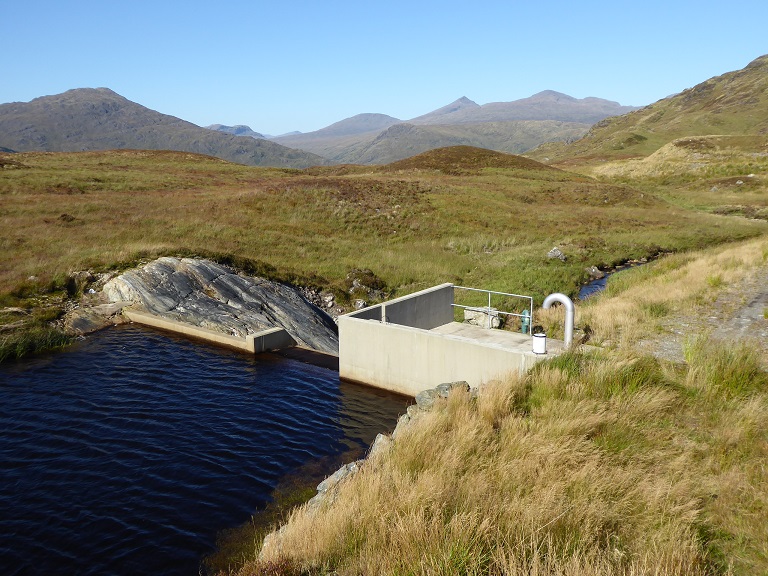
Ben Glas was the first of the hydro intakes I visited and there was very little sign of flood damage or infilling – it was still not possible to see the bottom of the pool. That doesn’t mean to say there has been no infilling but does suggest that where intakes are located matters. (The Allt Fionn scheme, which also appears unaffected, is tucked away in a high sided rocky gorge (see here for some old photos))
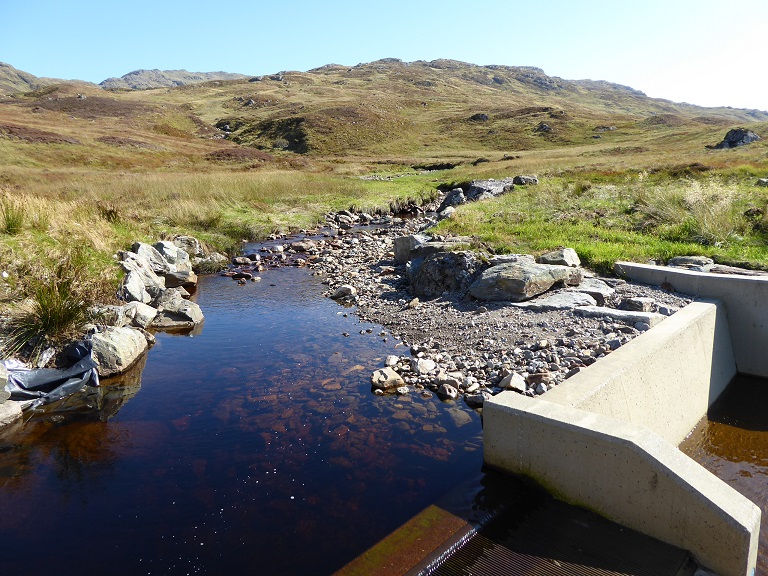
The other Ben Glas intake had been affected by some infilling and damage although this appears significantly far less than in the Allt a Chuillinn schemes. The flat beach on the right suggests some work might have been undertaken since 5th August to excavate the pool.
Now its possible these differences could in part be accounted for by the amount of rain that fell either side of Beinn Chabhair in the cloudburst. But other factors that could have affected this are the nature of the catchment, the size of the pools relative to the burn and the terrain around the intake and how this channelled the flood water. There are extensive peat bogs behind both hydro schemes, for example, and these may have absorbed just enough of the water to prevent it becoming catastrophic.
As alayperson with an amateur interest in our mountains I can only pose these questions. The LLTNPA, however, has a duty to start searching for the answers. It not only has a duty to put conservation first, as a National Park, its a statutory flood risk management authority and has been given the lead role for the Clyde and Lomond catchment to research natural flood prevention. As I pointed out in my last post, the LLTNPA has so far done nothing to progress this so, yesterday, I wrote to Roseanna Cunningham, the Minister for the Environment, asking her to get her officials to initiate an investigation into what has gone wrong..
The wider implications of the Glen Falloch hydro infilling for schemes across Scotland – what needs to be done?
So are two thirds of hydro schemes across Scotland now at risk of failure because of infilling of intakes in storm events? I don’t know but what I am certain of, having looked round Glen Falloch, is that some are and that has fundamental policy implications for how we address climate change.
In my letter to Roseanna Cunningham letter I pointed out that:
“where a run of river hydro scheme is abandoned, its possible that far more carbon will have been released into the atmosphere through scheme construction (concrete, pipe, use of machinery, damage to bog) than has ever been saved by the electricity generated by it. In other words, far from addressing global warming, some run of hydro schemes could become net contributors in terms of carbon emissions – leaving aside all their other environmental impacts. If that happens, the ostensible policy intention behind the promotion of run of river hydro schemes will have failed entirely.”
Leaving aside other environmental implications of the storm event in Glen Falloch, which I will consider in my next post, placing unconditional faith in run of river hydro schemes as a means of addressing global warming is misplaced. That it has been widely promoted is an example of vested interests at work. Our governments, both UK and Scotland, have supported enormous sums of money being spent to “incentivise the market”. This has resulted in a cash bonanza for developers and landowners – I will come back to the companies and people who own the Glen Falloch schemes – much of which now flows to Edinburgh and the City of London while the rest of us pay higher electricity prices. We would have been much better off and done much more to address global warming if our governments had spent the money on insulating houses and reducing fuel bills for the majority of the population.
Part of the money saved could have been invested in setting up a state renewable energy development service that could have been tasked with researching the impacts of the various forms of renewable energy development, producing guidance on their development in the long-term and then selecting suitable sites. In the case of run of river hydro that would have involved detailed consideration, informed by the work of experts without any self-financial interest in schemes going ahead, of where schemes should be located, how they should be designed, minimum standards for construction and the training required for all of this.
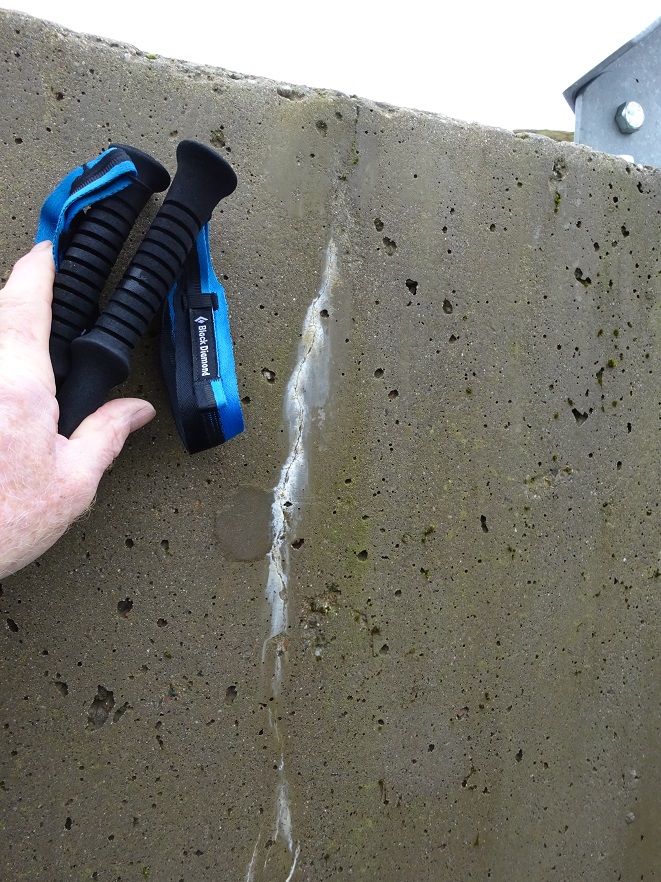
Instead of this, which would have saved a lot of wasted money, we have had an energy market free for all. Its also not to late to address this, indeed with the declaration of a Climate Emergency its even more important we change approach. For hydro we need to ensure that the development of schemes which are still in the pipeline or where construction is not complete – the Glen Etive schemes (see here) are a good example as is Invernoaden (see here) in the Loch Lomond and Trossachs National Park – do not result in more Glen Fallochs. We also need to adopt a national approach for tackling hydro schemes that do fail – restoration bonds or a hydro restoration tax anyone? – and to set national standard for the maintenance of existing intakes to prevent them turning into permanent works sites.
[I’d like to thank Kevin McGrath of Lomond Mountaineering Club for looking at all the schemes I had been unable to visit last Saturday, for sharing his photos and for an extensive discussion about what has happened. Without his contribution this post would have been much the poorer but only I am responsible for the final result].